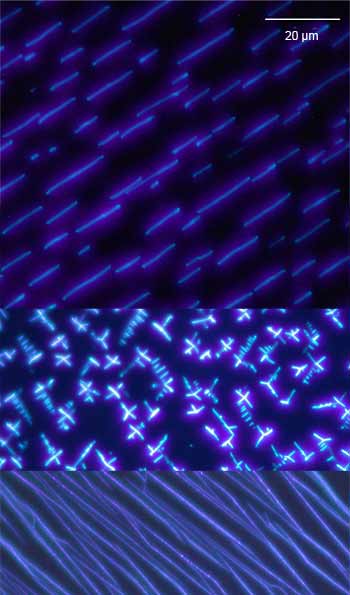Organic Molecular Nanotechnology
Katharina Al-Shamery, Rainer Koch, Arne Lützen, Horst-Günter Rubahn*
(* NanoSYD, Sonderborg, Denmark)
Research on nanofibers has developed in a dramatic way in the past few years in view of their potential as components of new optoelectronic devices. Nanofibers bear the potential to interconnect the macroscopic with the microscopic world. Recently CIS members discovered that well defined nano-shaped aggregates can be obtained from rod-like organic compounds with conjugated π-electron systems. During the course of these studies it was found that this approach offers promising possibilities of true bottom-up nano-engineering simply by modifying the molecular building blocks [1-9]. Organic molecules exhibit high luminescence efficiencies at low material densities, flexible spectroscopy and are easy and cheap to process as compared with their inorganic counterparts. The nanofibers investigated consist of para-substituted oligo-phenylenes and exhibited anisotropic luminescence, waveguiding, non linear response in case of asymmetrical substitution. They are furthermore candidates for random lasing. Joint research efforts were undertaken by theoretically predicting the optimum end-groups for a given application, performing the synthesis, growing the nanofibers out of the molecular building blocks under ultra-high vacuum conditions and characterising the linear and non-linear optical response. One of the highlights of this ongoing research was the detection of the space resolved second harmonic signal of a single fibre made via self assembly of 1-amino-4'''-methoxy-tetra-p-phenylene by means of laser scanning confocal microscopy which could be compared to its structure as measured with scanning force microscopy [2].
[1] M. Schiek, A. Lützen, K. Al-Shamery, F. Balzer, H.-G. Rubahn, Surf. Sci. 2006, 600, 4030-4033.
[2] J. Brewer, M. Schiek, A. Lützen, K. Al-Shamery, H.-G. Rubahn, Nano Lett. 2006, 6, 2656-2659.
[3] M. Schiek, A. Lützen, K. Al-Shamery, F. Balzer, H.-G. Rubahn, Crystal Growth & Design, 7 (2007) 229-233.
[4] M. Schiek, K. Al-Shamery, A. Lützen, Synthesis, 4 (2007) 613-621.
[5] F. Balzer, M. Schiek, A. Lützen, K. Al-Shamery, H.-G. Rubahn, Proceedings of the SPIE'S OE/LASER '07 conference, 6470-06, 2007.
[6] M. Schiek, J. Brewer, F. Balzer, A. Lützen, K. Al-Shamery, H.-G. Rubahn; Proceedings of the SPIE'S OE/LASER '07 conference, 6475-17, 2007.
[7] K. Al-Shamery, M. Schiek, R. Koch, A. Lützen, in "Organic nanofibers for next generation devices", K. Al-Shamery, H.-G. Rubahn, H. Sitter (Eds.), Springer Series in Materials Science, in press.
books
[8] K. Al-Shamery, H.-G. Rubahn, H. Sitter (Eds.), Organic nanofibers for next generation devices, Springer Series in Materials Science, in press
patents
[9] M. Schiek, K. Al-Shamery, A. Lützen, R. Koch, F. Balzer, H.-G. Rubahn, PCT/EP 2006/060717
Epi-fluorescence image from nanofibres grown via self assembly on muscovite-mica from
Top: para-Di-chloro-tetra-phenylene
Middle: para-Tetra-phenylene-ethinylene
Bottom: para-Di-methoxy-tetra-phenylene








